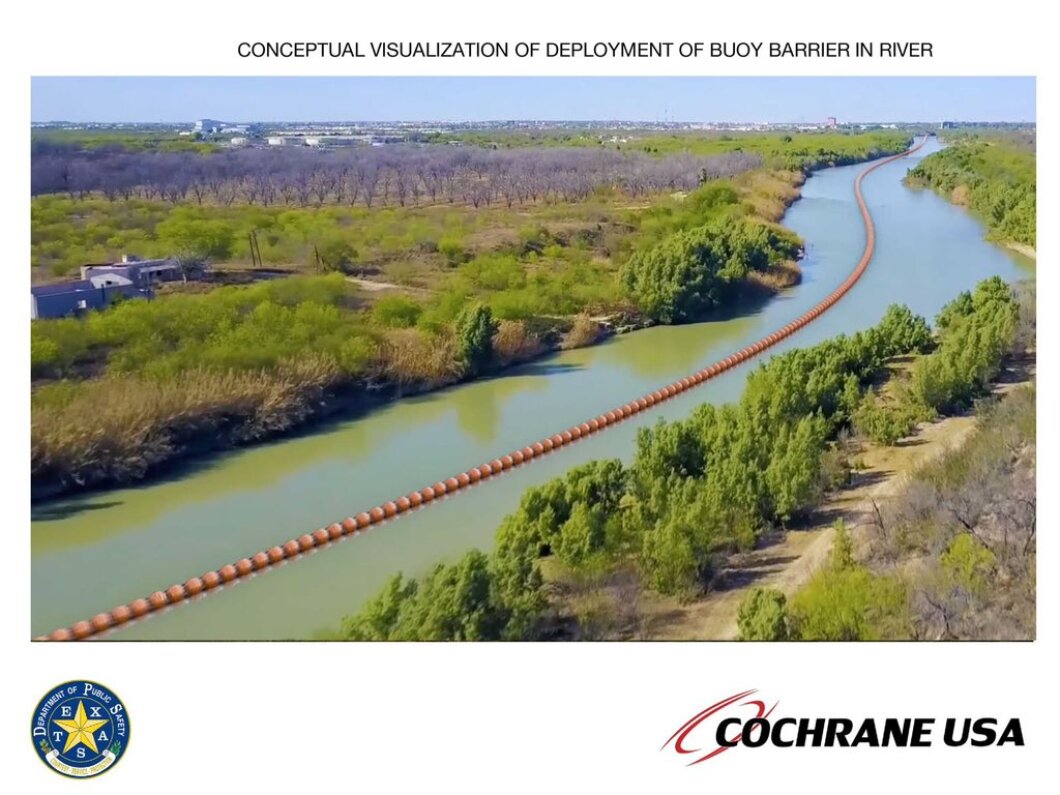
EAGLE PASS, Texas — Locals are optimistic for the state to install the first-ever water border barrier in the coming weeks, but some worry the measure is too little, too late.
In the coming weeks, Gov. Greg Abbott‘s (R-TX) administration plans to place a 1,000-foot-long strand of large red buoys in the center of the Rio Grande. The barrier, essentially the maritime version of a wall, is already in the process of being set up and is expected to make its debut after the Fourth of July.
GAS PRICES TODAY: WHERE TO FIND THE CHEAPEST FUEL ACROSS THE COUNTRY

The buoys, which to onlookers appear to be linked large red balls, will serve as another layer of border security and deter immigrants from crossing in certain areas and funnel those who do cross illegally to other parts of the river where the National Guard has installed concertina wire on the U.S. riverbank. It’s another move meant to funnel people to certain places where soldiers and Border Patrol are ready to apprehend those who walk up from the river.
The buoy project was underway June 21. Abbott said it would be completely installed by July 7.
Looking from Piedras Negras into Eagle Pass, at a small island in the middle of the Rio Grande, that was heavily used by migrants to cross into Eagle Pass, it appears the first stages of Governor Abbott’s floating buoy wall is being installed. pic.twitter.com/vhq4lF1g49
— Auden B. Cabello (@CabelloAuden) June 21, 2023
Alison Anderson, a mother and resident of nearby border town Del Rio, worried that the barrier would only lead smugglers to find other paths into the United States — possibly closer to her home.
“Only covering 1,000 feet is just more than likely going to create a shift in where the traffic crosses and not actually stop the crossings or even decrease the amount of crossings,” Anderson said. “As much as I appreciate the efforts the governor is taking, I have my own concerns with his plan with buoys, considering my family lives further upriver in Del Rio Sector, and if traffic does shift, that carries with it the potential for my family to see an even greater increase in the number of illegals, specifically the getaways, and smuggling from what we already see and endure on our own property.”
However, George Antuna, chairman of the Hispanic Republicans of Texas PAC and former Eagle Pass city manager, said residents really “appreciate” Abbott’s visits and the attention the state has paid to small communities like Eagle Pass.
“We along the Texas border can’t blame the governor for trying to protect our borders, and we thank him,” Antuna said. “The Biden administration has proven time and again that it does not care.”
Abbott has spent several billion dollars of taxpayer money bulking up resources and personnel along the state’s 1,250-mile shared border with Mexico since President Joe Biden took office in 2021.
On June 8, Abbott announced the forthcoming installation of “new marine floating barriers” that he said would “proactively prevent illegal crossings between ports of entry by making it more difficult to cross.” The project is expected to cost $1 million.

Col. Steve McCraw, director of the Texas Department of Public Safety, said during a press conference on June 8 that the buoys will be placed in an area of the river where the currents are most dangerous.
“We don’t want anyone to get hurt. In fact, we want to prevent people from getting hurt. We want to prevent people from drowning, and this is a proactive way,” McCraw said during the press conference with Abbott earlier this month. “We don’t want people to come across and continue to put themselves at risk when they go between the ports of entry.”
In April 2022, Texas Army National Guard Specialist Bishop E. Evans drowned in the river after he attempted to rescue someone crossing the river into Eagle Pass. Evans had been deployed to the border under Abbott’s Operation Lone Star border security initiative.
Abbott added that the state could decide to install “mile after mile after mile” of the inflatable barrier if it is successful in Eagle Pass. With a rising number of illegal crossings into Eagle Pass from Mexico border town Piedras Negras, the area could again become ground zero for illegal immigrant apprehensions in the coming weeks and months.
In May, the Del Rio Sector, which includes Eagle Pass, reported more than 26,000 illegal immigrant arrests, according to U.S. Customs and Border Protection data. Of Border Patrol’s nine sectors on the southern border, Del Rio placed third for arrests in May.
One city official in Eagle Pass was concerned that the buoy system could make fire department responses more difficult.
Eagle Pass Fire Department Chief Manuel Mello III previously shared with the Washington Examiner that his team has pulled deceased children and adults from the river at a shocking rate since the number of people choosing to cross the border in Eagle Pass skyrocketed in 2021.
In 2020, the fire department recovered up to 25 drowning victims in a year compared to 30 recoveries per month in mid-2022.
“In regards to the buoy system, I believe that may help deter some, but we will have to see,” Mello said in a text message over the weekend. “I hope to not see any deaths caused by the barrier. … In my personal opinion, I don’t like the idea of a barrier in the water, hoping it is not an obstacle in our rescue or recovery operations.”
The buoys will sit 4 feet above the water and have netting on their undersides that could be anchored to the river floor. McGraw said DPS tested out whether it was possible to swim under the buoys, climb over them, or go between them and that it would take “great effort” to do so.
CLICK HERE TO READ MORE FROM THE WASHINGTON EXAMINER
“When we’re dealing with 100 or 1,000 people, one of the goals is to slow down and deter as many of them as possible,” Abbott said on June 8. “Some may eventually get to the border where they are going to face that multi-layered razor wire and a full force of National Guard and DPS officers.”
The U.S. International Boundary and Water Commission, which enforces U.S.-Mexico water treaties, told NPR it was not consulted with or warned about the buoys before Abbott’s announcement. The IBWC is looking into what, if any, impact the buoys could have on the water agreements.





